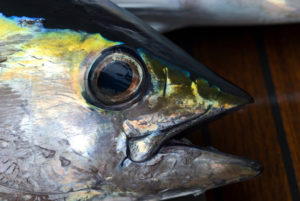"It's like putting on genetic reading glasses," says CSIRO researcher Peter Grewe of the next generation DNA sequencing technology that his team has applied to yellowfin tuna in the Pacific. "We've been asking questions on the origins of harvested tuna for a long time. Now, with these advanced and refined technologies, we’re starting to answer them."
The implications for improving the management of tuna fisheries are immense.
Without detailed knowledge on tuna population structure, tuna fisheries – worth many billions of dollars – have been largely managed along geopolitical lines. Two regional fisheries management organisations (RFMOs), the Inter-American Tropical Tuna Commission and the Western and Central Pacific Fisheries Commission, have essentially divided the Pacific Ocean into two and managed tuna fishing on that basis. While scientists suspected more complex tuna population structure and dynamics, scientific techniques lacked the power to test this assumption – until now.
Research published in Nature's Scientific Reports in November<1> sampled yellowfin tuna from three sites spanning the Pacific Ocean – in the Coral Sea (west), close to Tokelau (central) and off Baja California (east) – and subjected the samples to single nucleotide polymorphism (SNP) genotyping. The results were unequivocal – the samples represented three distinct breeding populations.
"Using these markers, we could assign the origin of the fish with almost 100% accuracy," says Grewe.
The key to sustainable yellowfin tuna fisheries
Three locations were sampled and three separate sub-populations were found. The next question is how many more sub-populations there are in the Pacific Ocean, and also in the Indian and Atlantic oceans. Thus, the next stage is a global survey of yellowfin tuna, to build a more complete picture of breeding stocks around the globe.
Understanding where (and when) the tuna breed is the key to developing sustainable tuna fisheries. The fisheries can then be managed as breeding populations, with reproductive stages protected and overfishing prevented – a quantum leap for their long-term sustainability, compared with current management arrangements.

The sampling and analysis methods used by Grewe and team are relatively inexpensive and fast, and with good international cooperation the global survey could be completed within a few years.
At the same time, the team is looking for ways to streamline the process, to speed it up and also make it more widely available and cost-effective. A simple gene tagging tool has recently been developed that facilitates mark–recapture and tissue sampling<2>.
Combining these recent developments, effective routine monitoring of ocean catch is well within reach.
A tool against illegal fishing
The ability to quickly and cheaply pinpoint the origin of a fish will not be welcomed by those engaged in 'illegal, unreported and unregulated' (IUU) fishing, which accounts for an unknown but significant proportion of the global tuna catch. Illegally caught fish often enters the market via the practice of catch substitution – deliberately misleading authorities and consumers on the origin of the fish.
Any measures to deter IUU fishing will greatly contribute to the sustainability of fisheries, both environmental and economic. As well as generally disregarding sustainability aspects of fisheries, IUU fishing may have broader negative impacts on, for example, sea turtles and seabirds. These are in addition to economic losses suffered by the industry and governments, and real food security implications for coastal communities.

Yellowfin tuna may be the first species to benefit from these advanced genetic tools, but the tools have been designed to be general and can be used with other fish species, particularly other migratory ocean species.
A CSIRO-coordinated project soon to launch will unite countries including Australia, Spain, France, the Maldives and Indonesia to apply these latest advances to a range of other species such as other tunas, sharks and billfish. The research paves the way for more detailed understanding of these migratory species and more sustainable ocean fisheries worldwide.
References
<1> Grewe P.M. et al. (2015) Evidence of discrete yellowfin tuna (Thunnus albacores) populations demands rethink of management for this globally important resource. Scientific Reports 5:16916. DOI: 10.1038/srep16916
<2> Bradford R.W. et al. (2015) A new tool in the toolbox for large-scale, high-throughput fisheries mark-recapture studies using genetic identification. Marine and Freshwater Research.
